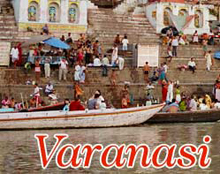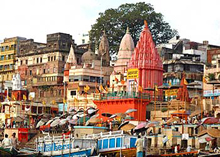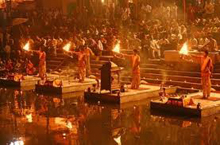
Home
   |
VARANASI SPECIAL TOUR
Inclusions: Description :" Varanasi ″ the essential part of all spiritualism and mysticism of India, is situated on the bank of celestial river Ganges which is the life line of thousands of Indian.Like a loving mother this holy city is pampering all the religion as Hinduism, Jainism and budhhism.While Preceding deity is Lord Shiva here yet very surprisingly Vaishnavism and Shaivism have co-existed in Varanasi harmoniously. Holy River Ganga further enhances its sanctity. River Ganga is regarded as goddess and whole religious and cultural activities revolve around Ganga and Ganga Ghats. Thousands of pilgrims come every year to take holy dip In Ganga with the deep faith that the sacred river will wash off all their sins .this is the firm faith of Hindu believers that bathing in the Ganges remits sins and that dying in Kashi will set their spirit free from cycle of rebirth. Varanasi, is estimated by myth and legend, and sanctified by religion but wonderfully it is famed as “center of education ”also because Varanasi is home to four great universities: Banaras Hindu University- the biggest University in Asia. Mahatma Gandhi Kashi Vidyapeeth, Central Institute of Higher Tibetan Studies and Sampurnanand Sanskrit University. This city is very much associated with the life of Gautam Buddha .Lord Buddha has chosen this place to give his first sermon to his disciples, to teach truth of life. Buddha himself regarded this place as one of four sacred places of earth. It is the birthplace of Suparshvanath, Shreyansanath, and Parshva, who are respectively the seventh, eleventh, and twenty-third Jain Tirthankars thus Varanasi is a great pilgrimage centre of Jainism also. Besides being religious centre the city is also famous for musical achievement. Banaras Gharana is one of the most important parts of Indian classical dance and music. Thus one can come to Varanasi not only to satisfy his spiritual quest but also to enjoy the other beautiful facets of the city. Legendary history Being one of the oldest city of world Varanasi is related to various myth and legend. According to legend, the city was founded around 5,000 years ago by the Lord Shiva, which makes it one of the most essential pilgrimage destinations in the country. Many Hindu scriptures, including the Rigveda, Skanda Purana, the Ramayana, and the Mahabharata, chant the glory and past of the city and consider it one of the seven sacred cities of the Hindus. Varanasi is situated between the two tributaries of River Ganga- Varuna to the north and Asi to the south. Varanasi combines the name of both these rivers. This sacred place is city of legends. During the time of Gautama Buddha (born circa 567 BCE), Varanasi was the capital of the Kingdom of Kashi. The celebrated Chinese traveler, Xuanzang, attested that the city was a center of religious, educational, and artistic activities, and that it extended for about 5 km along the western bank of the Ganges. The most fascinating part of the holy city of Varanasi is that almost all the activities seem to revolve around river Ganga and its Ghats. Hindus regard Kashi as one of the Shakti Peethas, Hindus of the Shakti sect make a pilgrimage to the city because they regard the river Ganges itself as the Goddess Shakti. Adi Shankara wrote his commentaries on Hinduism here, leading to the great Hindu revival. The history of Varanasi is also related to legends which closely associate the city with Buddhism .Lord Buddha himself regarded kasha as one of the four pilgrimage sites,the others being Kushinagar, Bodh Gaya, and Lumbini. In the residential neighborhood of Varanasi lies Sarnath, the site of the deer park where Gautama Buddha is said to have given his first sermon about the basic principles of Buddhism. Varanasi is a pilgrimage site for Jains along with Hindus and Buddhists. It is believed to be the birthplace of Parshvanatha, the twenty-third Tirthankar. Islamic culture has also had an great influence on Varanasi. Ganges Aarti-worshipping the divine river The Great Ganga aarti is most important ritual of Varanasi performed daily on the river bank. Divine river Ganga descended on earth for the sake of well being of human being. So all over in India the river Ganga is being revered as a mother and worshipped as goddess. A large number of tourist and devotees assemble on the river banks of Ganga and chant the glory and obligation of Ganga with burning earthen lamp. This ritual is called Ganaga Arti. On such occasions a tone of hymn which is called Maa Ganga aarti is being sung. Aarti is a tone of worship, love towards god. And when thousands of people sing the Aarti with burning g earthen lamps it creates such heavenly sight which can mesmerize you with paramount of spiritual joy . The grand Aarti Although Aarti is organized daily morning and evening yet you can enjoy grand aarti of Ganga at evening, at Dasaashwamedh Ghat, conducted every sunset by five white-robed priests. These five young men sway in apparently choreographed movements, worshiping the river goddess with incense, camphor, flowers and earthen lamps. Thousands of illuminated lamps are immersed in the waters of the holy Ganges and the floating lamps add a divine look to the river at dusk. Every evening at five, a magical aarti is performed at Dasashwamedh Ghat. Halt your boat right at the steps for the best view. The presiding priests stand on a wooden chauki in the water. To the chant of Sanskrit mantras, and the clash of cymbals and drums, the river is worshipped with flowers, incense, sandalwood, milk and vermilion. First the blazing camphor lamp and then the many- flamed aarti lamps are raised high and then arched back to the water, the dark river reflecting the golden flames as Ganga accepts the worship. People often brings with them a little cup made of dough surrounded with marigold and rose petals to make them float in river with a prayer to mother Ganga, the Himalayas.The smell of veneration is in air, with the lightning of diyas and enchanting tune all way round fills the everyone’s heart. Pilgrimage Attractions of Varanasi Vishwanath Temple The Kashi Vishwanath temple, dedicated to Lord Shiva, is the most sacred shrine in Varanasi. It stands in the heart of this city with its full majesty. People come from all parts of seek the blessings of Lord Vishwanath(Lord Shiva). This temple makes Varanasi a place of great religious importance to the Hindus, because Vishwanatha, as one of twelve Jyotirlinga of the Lord Shiva is enshrined here. It is said that a single view of Vishwanatha Jyotirlinga is considered to merit more than that of other jyotirlingas. Millions of Indian and foreigner pilgrims swarm the temple to seek divine tranquility by the darshan of this Jyotirlinga which confers release from the bondages of inescapable entanglements from physical world. The temple becomes overcrowded during some special occacasion like Mahashivaratri,Vasant Panchmi,Makar sankranti etc. There are five daily aartis at Vishwanath Temple. Eleven priests prepare the black stone linga for the aarti amidst loud chanting . the linga is first bathed in the holy waters of Ganga, and then anointed with sandalwood paste, and an intoxicating concoction of cannabis or bhang, honey, ghee and finally milk. It is decorated bountifully with garlands of marigold, rose and jasmine, to the sound of conch shells, bells and drums, the many-flamed lamps waved before the god. The whole temple precinct is suffused with the heavy fragrance of incense. The entire place acquires a very pious feel with the chants of Vishwanath Aarti. Bharat Mata Temple The Bharat Mata temple is the only temple dedicated to Mother India. The Bharat Mata temple was built by Babu Shiv Prasad Gupt in the Mahatma Gandhi Kashi Vidyapeeth. It is located in the Mahatma Gandhi Kashi Vidyapeeth campus. The statue of Bharat Mata is built in marble and is a model of undivided India, depicting the mountains, plains and oceans. The most peculiar thing about the Bharat Mata Temple is that instead of the customary gods and goddesses, it houses a relief map of India, carved out of marble. Tulsi Manas Temple The Tulsi Manas Mandir (temple) is dedicated to Lord Rama. The temple is believed to be built at the place where Tulsidas composed the ‘Ramacharitramanas’, the greatest epic. It provides us with thorough depiction of the life and deeds of Lord Rama. The walls of the Tulsi Manas temple are adorned with “Dohas” from Ramcharitramanasa.. Constructed by family of Varanasi, this modern temple is dedicated to Lord Rama. Durga Temple Durga temple is also one of significant temples of Varanasi. Which is dedicated to Goddess Durga “Goddess of power” It was built at some point of time in 18th century. The structural design is of Nagara Style, which is typical of North India. The temple is accompanied by a rectangular tank of water called Durga Kund. According to legends, the present statue of Goddess Durga was not made by man but appeared on its own in the temple. Thousands of Hindu devotees visit the Durga temple during Navratri and other auspicious occasions. The temple has multi-tiered spires and is stained red with ochre, signifying the red colour of DurgaEvery year on the occasion of Nag Panchami, the act of depicting Lord Vishnu reclining on the coiled-up mystical snake or “Shesha” is repeated in the Kund. Baba Keenaram Sthal Headquarter and world fame Pilgrim of Aghora scet. Work place of great saint Baba Keenaram. One of the most Visiting Places, of Varanasi, by Researchers, Documentaries Maker,Writers and Tourists. Vishalakshi temple This temple is dedicated to Vishalakshi (means wide-eyed) or Parvati , the consort of Lord Shiva and considered as incarnation of power itself. Sankat Mochan Temple is dedicated to Lord Hanuman who has been considered as greatest devotee of Lord Ramchandra ,and his devotion towards Lord Rama Made him God himself. And it is believed that God hanuman can solve all the problems of human life and minimize the worse effect of planet Saturn that’s why the temple is very popular with the local citizens. It is a place for many yearly religious as well as cultural festivals. Temple is one of the sacred temples of Hindu god Hanuman in the city of Varanasi. Tulsidas, the author of the famous Hindu epic Ramacharitamanasa, founded the Sankat Mochan temple. Every Tuesday and Saturday, thousands of people come to temple to offer prayers to Lord Hanuman and get his blessings. The New Vishwanath Temple The New Vishwanath Temple, also called Birla Mandir, mainly funded by Raja Birla of the Birla family of industrialists, was built as a replica of the old Kashi Vishwanath Temple. Planned by Madan Mohan Malaviya, the temple is part of the Banaras Hindu University campus, and stands for national revival. The temple is open to people of all castes and religions. Kalbhairav Temple It is the ancient temple of Varanasi near the Head Post Office, VishesharGanj. God KalBhairav is believed as “Kotwal Of Varanasi”,without his permission no one can stay in Kashi. Sarnath Sarnath is one of most important tourist attraction of Varanasi. It is 10 Km away from the Varanasi. The place is famous as Buddha has given his first sermon about the truth and duties of life here. The celebrated Mantra, ‘Buddham Sharanam Gachhami’, owes its origin to Sarnath. Buddha included Sarnath along with Lumbini, Bodh Gaya and Kushinagar as the four places he thought to be sacred to his followers. It makes Sarnath one of the most venerated Buddhist places. Dashashwamedh Ghat The main bathing ghat located close to Vishwanath Temple, is associated with Hindu mythology. It is the place where Lord Brahma is said to have sacrificed ten horses during the Dasa Ashwamedha yagya to celebrate the return of Lord Shiva on earth. It is said that bathing here gives the same merits as received by doing the ‘ten horse sacrifice’ that were performed here. Durga Ghat located near the Durga temple is one of the most well known Ghats in Varanasi which was built in 1772 by a saintly person known as Narayana Diksit. A small temple dedicated to Kharva Narsimha is also located nearby this ghat. Tulsi Ghat the named after the famous 16th century poet Tulsidas is located near the Assi ghat. This poet who composed the great Indian epic, Ramcharitmanas has spent many years in varanasi till his death in 1623A.D. Legend has it that when his manuscript fell into the river Ganga, it kept floated instead of sinking and disintegrating. Earlier known as Lolark ghat, the place is a center of cultural activities. Ramlila, the stage representation of the story of Lord Rama was staged here for the first time and to commemorate this, a temple of Lord Rama was built on the Tulsi ghat. Many reminiscences of Tulsidas has been preserved here. Mandir Ghat, is one of the oldest ghat in the city located to the north of Dashashwamedh Ghat. Originally known as Somesvara Ghat, this place by Raja Savai Man Singh has an exquisite structure of Rajput architecture with fine balconies at the north end. A small observatory founded by the Raja can also be seen in the ghat. Man mandir ghat houses temples such as Sthuladanta Vinayaka, Rameshwara and Someshwara. Someshwar temple is known for its lingam of Someshwar (the Lord of the Moon) which is the replica of that in the Gujarat Somanath temple. How to reach Varanasi by Air Varanasi is of the greatest pilgrimage attraction of India. So it is well connected to major cities in India including Delhi, Mumbai and Agra. There are daily domestic flights from Varanasi to these cities. International travelers can get connecting flights from Delhi, which is 810 km away. Delhi is well linked with all major cities in India and many cities abroad. Varanasi by Train Varanasi is well connected with all major railway stations in India. There are two railheads nearby, namely Varanasi junction and the Kashi junction. Many express trains connect Varanasi with other major cities. Varanasi by Bus State owned public bus services connect Varanasi with other holy cities in Uttar Pradesh and neighboring states. Regular private bus services are available from nearby cities to Varanasi. Best time to visit All though this holy place remains full of crowd round the year yet Varanasi being situated in the northern part of India has a humid subtropical climate with high variation between summer and winter temperatures and as It has a continental climate Summers stretches from early April till October with monsoon season so best suggested time to Visit Varanasi is October to March. |